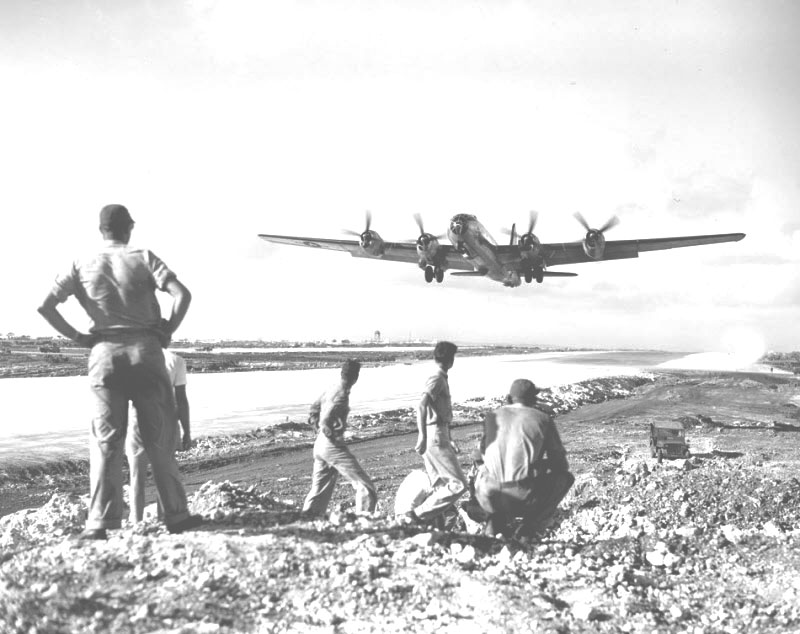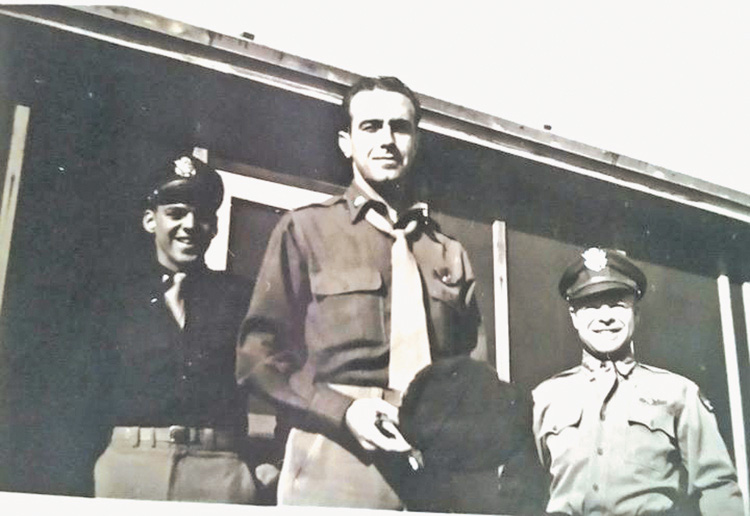
Not Everyone Returned
| A MEMORIAL DAY SALUTE TO AN OZARK WWII VETERAN JUST A DAY’S WORK FOR JACK FISCHER Seated behind the yoke of his B-29 for another bomb run, Jack Fischer probably didn’t think much about what might be called a deadly trial and error air campaign reaching into Japan’s homeland. As is often the case with military campaigns, the high ranking brass and analysts gave their best attack strategies a shot. Some worked, some did not. Trouble was that the cost of the learning curve could be loss of human lives. It was just how things worked, how projects succeeded, battles were won. Fischer and the 10 crewmen under his command all knew that. So, starting his preflight checks, crew checks, engine run-ups, then rolling down the runway on Saipan in 1945, Army Air Corps pilot Capt. Jack Fischer focused on the day’s work — fly his crew 1500 miles to Japan, make a low-level bombing raid over Japan and hopefully get everyone back alive and in one piece. The “hopefully” part was stacked against Fischer. Japanese fighter planes might shoot him out of the sky. Anti-aircraft batteries would certainly try as well. Ever-present mechanical gremlins might raise their ugly heads in-flight, working to bring the giant bomber down. Fischer might get blown off course, get disoriented in weather or smoke, spend too much time in the air, run out of fuel, crash, burn, or see his men flounder in a raft on the Pacific Ocean. Even if everyone survived that, worse fates awaited. Death might be preferable to becoming a Japanese POW. Every airman had heard the stories –starvation, deprivation, torture, beheadings. Pick any of the factors, one or another of them had taken lots of other crews. With no satellite communication and sparse radio contact, the crew had a 3000 mile round trip and 15 hours of flight time to ponder things. Few probably thought about how their efforts, along with Marines, soldiers, sailors, and coastguards men would end the war in the PacificTheater. HOPSCOTCH ACROSS THE PACIFIC It was a step by step goal of hopscotch. A vast network of tiny island across the Pacific needed to be taken from the Japanese in order to establish airfields for bombing raids on Japan. Those potential bomber bases extended from the Aleutians north near Alaska to thousands of miles away into the South Pacific. Jack Fischer would fly out of Saipan, an island of the Mariana chain won back from occupying Japanese troops at a high price of lives by U.S. Marines. They secured the valuable real estate needed to build a bomb line into Japan. Next came combat engineers. Sometimes the work on hastily constructed airfields began while battles were still in-progress. Marines invaded and secured Saipan in June 1944. Three thousand Americans and 24,000 Japanese lost their lives. INITIAL BOMBER CAMPAIGN NOT GONE WELL In 1945, Jack Fischer flew his H – 29, Maidens Prayer, tail code T 28, serial number 4461678 under San Francisco’s Golden Gate Bridge, headed to the war the Pacific. He flew missions from Saipan that year. The air campaign against the Japanese mainland and not been going well at the start of the effort. First bombing attempts by B – 29’s over Japan were from around 30,000 feet. The targets were factories that manufactured aircraft and other equipment used in the Japanese war effort. The daytime bombing effectiveness had not been good. The targets sustain little damage, whether in cloud cover hindered operations. Japanese anti-aircraft defenses were accurate. Two other factors played a role. B – 29’s encountered jet-stream winds from the West with velocities of 200 mph. American bombers heading for Japan flew into them. Although B – 29’s were capable of speeds of 400 mph, max fuel efficiency meant cruising around 195 mph. Aircraft running out of fuel brought bombers down. Engine failures were more than common on the heavily laden B – 29’s. In early 1945, aborted flights, planes lost, due to engine failure were at 23 percent per mission. Fuel tanks and guns were removed from the aircraft cut down on the weight, and maintenance operations were approved. The changes reduced the engine failures. The failure of the high-altitude missions sent Air Corps brass back to the operational drawing board. The plan that resulted called for low-level bombing of the Japanese factories. Instead of high explosive bombs, incendiary bombing was used. The high-altitude bombing raids had been conducted during the daytime. Incendiary raids took place at night from altitudes of five to six feet. The night flights also eliminated bombers taking off in mass formation. This also saved fuel. Planes took off on their own. Losses from Japanese fighter plane attacks ran high. During a raid, one bomber wing reportedly lost 43 aircraft. Refining the battle plan further, discovering the Japanese factories were supplied with material and parts from cottage industries. Incendiary raids targeted those off factory sites. As raids progressed, Japanese aircraft production decreased, as did enemy fighter plane activity. Back home, the B – 29’s manufacturing saw ongoing modifications based on aircrew combat reports. Such was the wartime atmosphere Jack Fischer and his crew dealt with. JACK’S AVIATION INTEREST BEGAN IN OZARKS While still a teenager, he became interested in flying. He attended Southern Missouri State and Drury University. At age 21, he attended flight school at Springfield Flying Service then located at the city’s downtown airport. Accepted into the Army Air Corps as an aviation cadet, shipped off for training at the Air Corps Center in Stockton California, then went to Albuquerque New Mexico for heavy bomber training. From Saipan, Fischer flew those low-level incendiary bombing missions of which many B – 29’s crews did not make it back from. As did most of his World War II peers, after the war, Jack didn’t say much about his wartime experience. “He never really talked about it much,” Pete Fisher said of his father. Pete, manager of Sunfest Market in Branson, does know that his dad was lucky to survive the bombing runs to Japan. Old and discolored typewritten reports, now belong to Pete, bear witness to the life-threatening existence Jack Fischer lived during those war years. The official, after mission reports, written his dad Capt. Jack Fischer speak volumes of the drama and heroism of other aircrews flying along with Fischer’s plane on the bombing runs to Japan. ” Aircraft — Little Jo — 4/29/45 Mission #63 — Aircraft damages over target…crew bailed out soon after leaving coast of Japan. 11 parachutes seen, 6 crew members rescued 5/1/45.“ Another entry records, “Lost #2 & 4 engine after take-off — Ditched between Saipan and Tinian. 3 crew members rescued.” And another entry, “Ditched due to mechanical to mechanical failure of fuel system transfer. 4 crew members rescued.” And so the reports go on–engine fires and failures, shot-up aircraft, aircrew bailouts of airmen Fischer probably knew but would never see again. AIR CREWS MOST MEMORABLE MISSIONS Amid reports of downed planes and bombing missions, another report from a pilot states that pilots and crews considered their best and most memorable missions were the ones dropping food and medical supplies outside POW camps housing Allied troops awaiting their pending rescued release. JACK FISCHER’S LONG FULL LIFE Fischer and his crew of Maiden’s Prayer survived the war in the Pacific. On his return flight home,. Fischer flew his B – 29 back under the Golden Gate Bridge His days of courage and daring did not end with the war. He returned to service in the U.S. Air Force. While stationed in Fairbanks Alaska, Fischer flew a rescue mission to the North Pole in a C–47 aircraft. Completing the rescue, the C-47, equipped with landing skis, took-off while ice and melting snow were breaking-up and melting under it. Fischer received an Air Force Commendation Medal for his meteorological work during the Cuban missile crisis. He retired, at age 44, from the U.S. Air Force as a Lt. Colonel. After retirement, he started a successful building maintenance company in Springfield, Mo., which he operated until 1985. John C. “Jack” Fisher passed away, at age 94, in Springfield, Mo., on August 6, 2014. He was born on August 3, 1920. Jack Fischer’s son, Pete, is the longtime manager of Sunfest Market located across from Holiday Hills Golf Course and Resort in the Mount area of town. If you happen to stop by the market, say hello to Pete and thank him for his father’s service to our country. (This story first appeared in Both Sides of the Bridge Magazine; B-29 Photos courtesy National Archives; Jack Fischer photos courtesy Pete Fischer) | |
